HA 3011 Advanced Financial Accounting: IFRS, GAAP, and Revaluation
VerifiedAdded on 2023/06/12
|8
|2123
|98
Essay
AI Summary
This assignment delves into advanced financial accounting, focusing on the differences between International Financial Reporting Standards (IFRS) and Generally Accepted Accounting Principles (GAAP). It addresses the relevance and reliability of financial statements, examining the role of understandability, relevance, reliability, and comparability in financial reporting. The assignment also explores various theories such as the Public Interest Theory, Capture Theory, and Economic Interest Theory in relation to government regulation and business practices. A significant portion of the work is dedicated to the revaluation of assets under IFRS versus local GAAPs, discussing the impact of revaluation decisions on financial statements and shareholder wealth. The document concludes that while revaluation has complexities, proper reporting frameworks are crucial for disclosing relevant information.
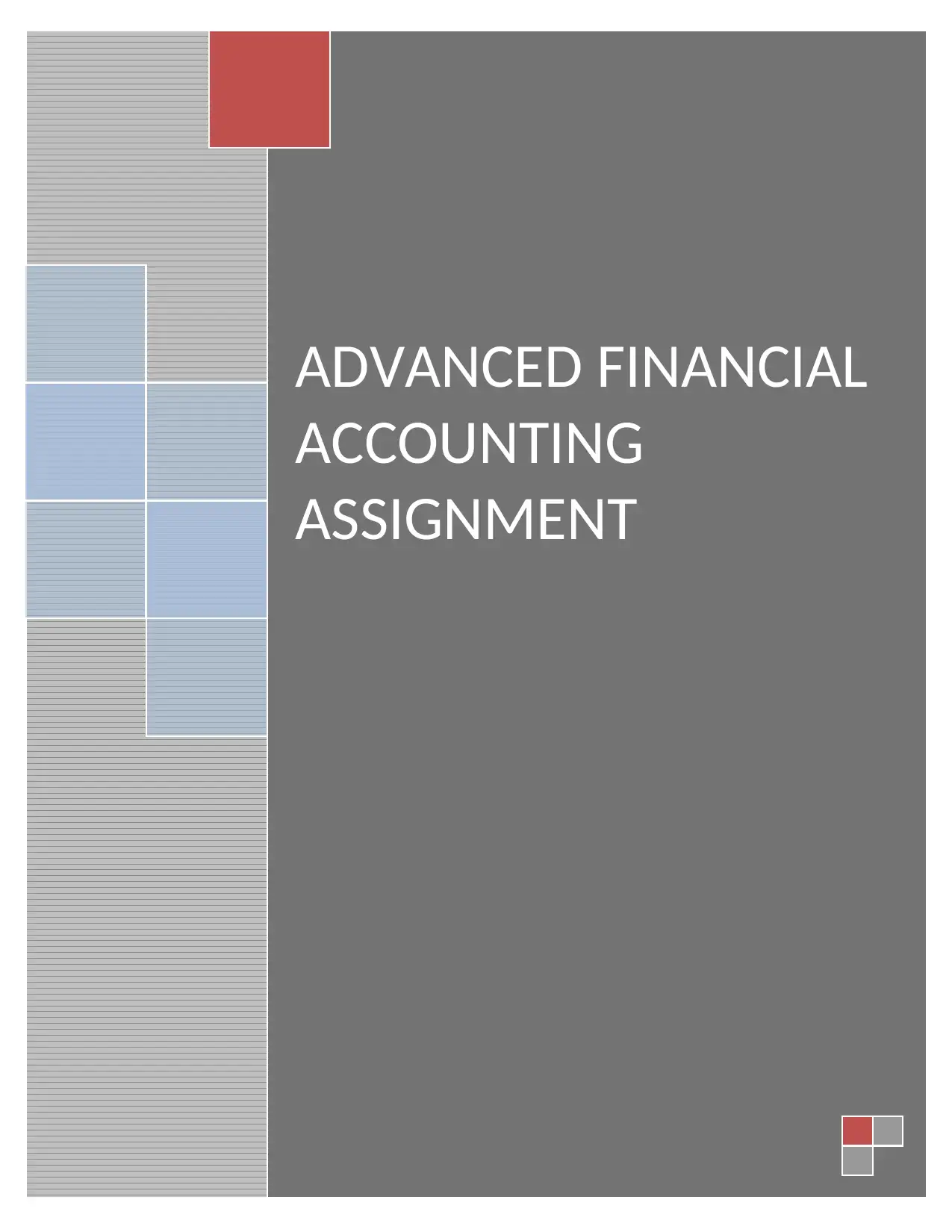
The
ADVANCED FINANCIAL
ACCOUNTING
ASSIGNMENT
ADVANCED FINANCIAL
ACCOUNTING
ASSIGNMENT
Paraphrase This Document
Need a fresh take? Get an instant paraphrase of this document with our AI Paraphraser

1
By student name
Professor
University
Date: 25 April 2018.
1 | P a g e
By student name
Professor
University
Date: 25 April 2018.
1 | P a g e
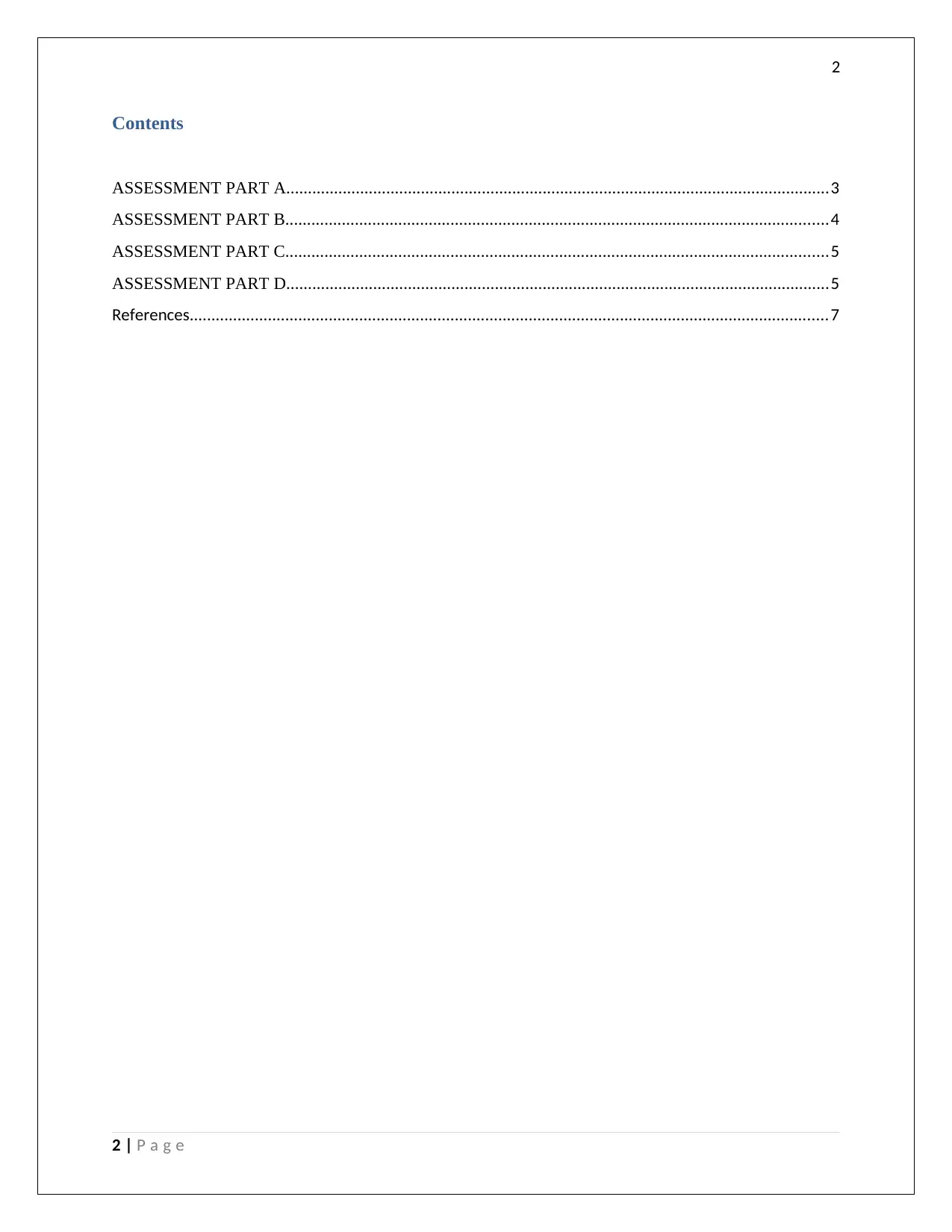
2
Contents
ASSESSMENT PART A.............................................................................................................................3
ASSESSMENT PART B.............................................................................................................................4
ASSESSMENT PART C.............................................................................................................................5
ASSESSMENT PART D.............................................................................................................................5
References...................................................................................................................................................7
2 | P a g e
Contents
ASSESSMENT PART A.............................................................................................................................3
ASSESSMENT PART B.............................................................................................................................4
ASSESSMENT PART C.............................................................................................................................5
ASSESSMENT PART D.............................................................................................................................5
References...................................................................................................................................................7
2 | P a g e
⊘ This is a preview!⊘
Do you want full access?
Subscribe today to unlock all pages.

Trusted by 1+ million students worldwide
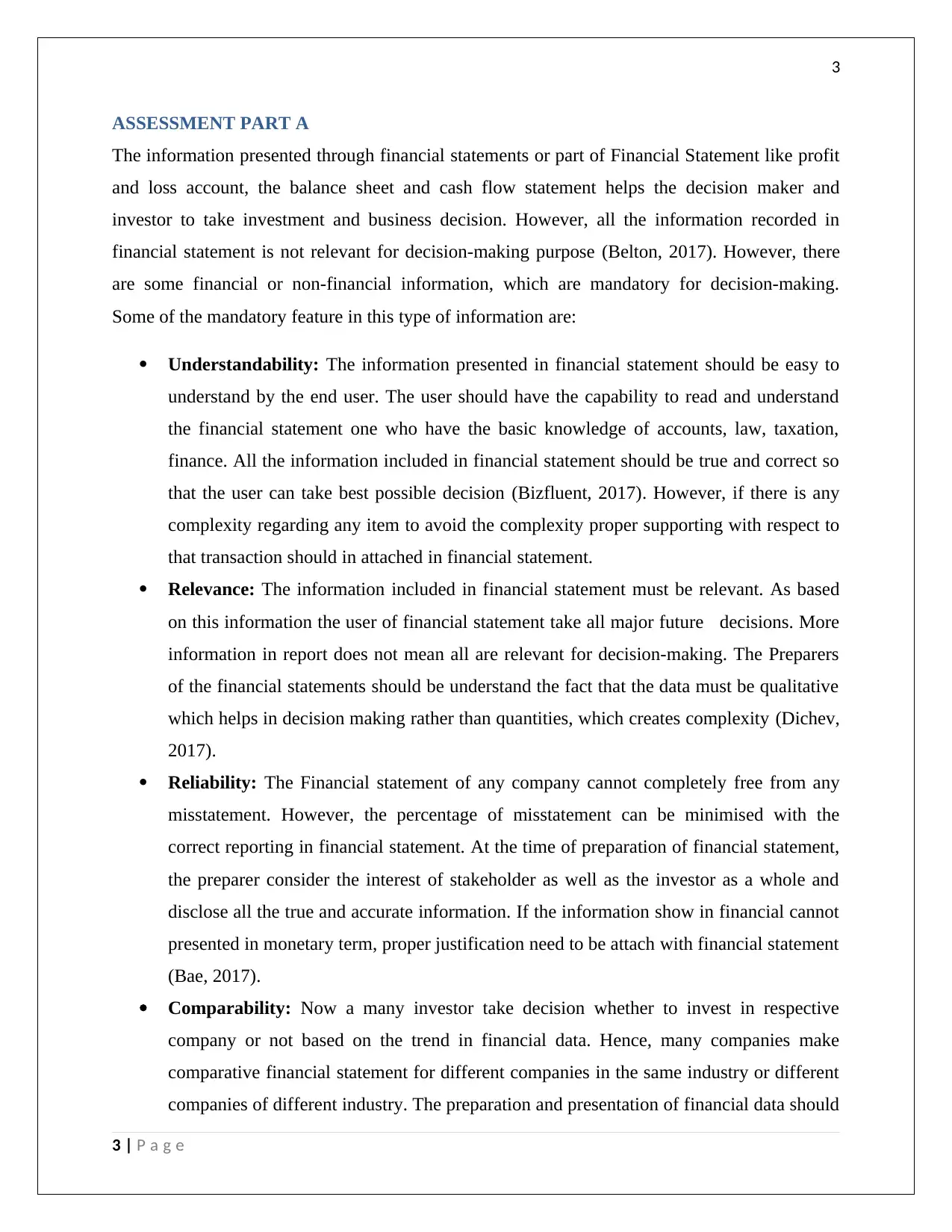
3
ASSESSMENT PART A
The information presented through financial statements or part of Financial Statement like profit
and loss account, the balance sheet and cash flow statement helps the decision maker and
investor to take investment and business decision. However, all the information recorded in
financial statement is not relevant for decision-making purpose (Belton, 2017). However, there
are some financial or non-financial information, which are mandatory for decision-making.
Some of the mandatory feature in this type of information are:
Understandability: The information presented in financial statement should be easy to
understand by the end user. The user should have the capability to read and understand
the financial statement one who have the basic knowledge of accounts, law, taxation,
finance. All the information included in financial statement should be true and correct so
that the user can take best possible decision (Bizfluent, 2017). However, if there is any
complexity regarding any item to avoid the complexity proper supporting with respect to
that transaction should in attached in financial statement.
Relevance: The information included in financial statement must be relevant. As based
on this information the user of financial statement take all major future decisions. More
information in report does not mean all are relevant for decision-making. The Preparers
of the financial statements should be understand the fact that the data must be qualitative
which helps in decision making rather than quantities, which creates complexity (Dichev,
2017).
Reliability: The Financial statement of any company cannot completely free from any
misstatement. However, the percentage of misstatement can be minimised with the
correct reporting in financial statement. At the time of preparation of financial statement,
the preparer consider the interest of stakeholder as well as the investor as a whole and
disclose all the true and accurate information. If the information show in financial cannot
presented in monetary term, proper justification need to be attach with financial statement
(Bae, 2017).
Comparability: Now a many investor take decision whether to invest in respective
company or not based on the trend in financial data. Hence, many companies make
comparative financial statement for different companies in the same industry or different
companies of different industry. The preparation and presentation of financial data should
3 | P a g e
ASSESSMENT PART A
The information presented through financial statements or part of Financial Statement like profit
and loss account, the balance sheet and cash flow statement helps the decision maker and
investor to take investment and business decision. However, all the information recorded in
financial statement is not relevant for decision-making purpose (Belton, 2017). However, there
are some financial or non-financial information, which are mandatory for decision-making.
Some of the mandatory feature in this type of information are:
Understandability: The information presented in financial statement should be easy to
understand by the end user. The user should have the capability to read and understand
the financial statement one who have the basic knowledge of accounts, law, taxation,
finance. All the information included in financial statement should be true and correct so
that the user can take best possible decision (Bizfluent, 2017). However, if there is any
complexity regarding any item to avoid the complexity proper supporting with respect to
that transaction should in attached in financial statement.
Relevance: The information included in financial statement must be relevant. As based
on this information the user of financial statement take all major future decisions. More
information in report does not mean all are relevant for decision-making. The Preparers
of the financial statements should be understand the fact that the data must be qualitative
which helps in decision making rather than quantities, which creates complexity (Dichev,
2017).
Reliability: The Financial statement of any company cannot completely free from any
misstatement. However, the percentage of misstatement can be minimised with the
correct reporting in financial statement. At the time of preparation of financial statement,
the preparer consider the interest of stakeholder as well as the investor as a whole and
disclose all the true and accurate information. If the information show in financial cannot
presented in monetary term, proper justification need to be attach with financial statement
(Bae, 2017).
Comparability: Now a many investor take decision whether to invest in respective
company or not based on the trend in financial data. Hence, many companies make
comparative financial statement for different companies in the same industry or different
companies of different industry. The preparation and presentation of financial data should
3 | P a g e
Paraphrase This Document
Need a fresh take? Get an instant paraphrase of this document with our AI Paraphraser
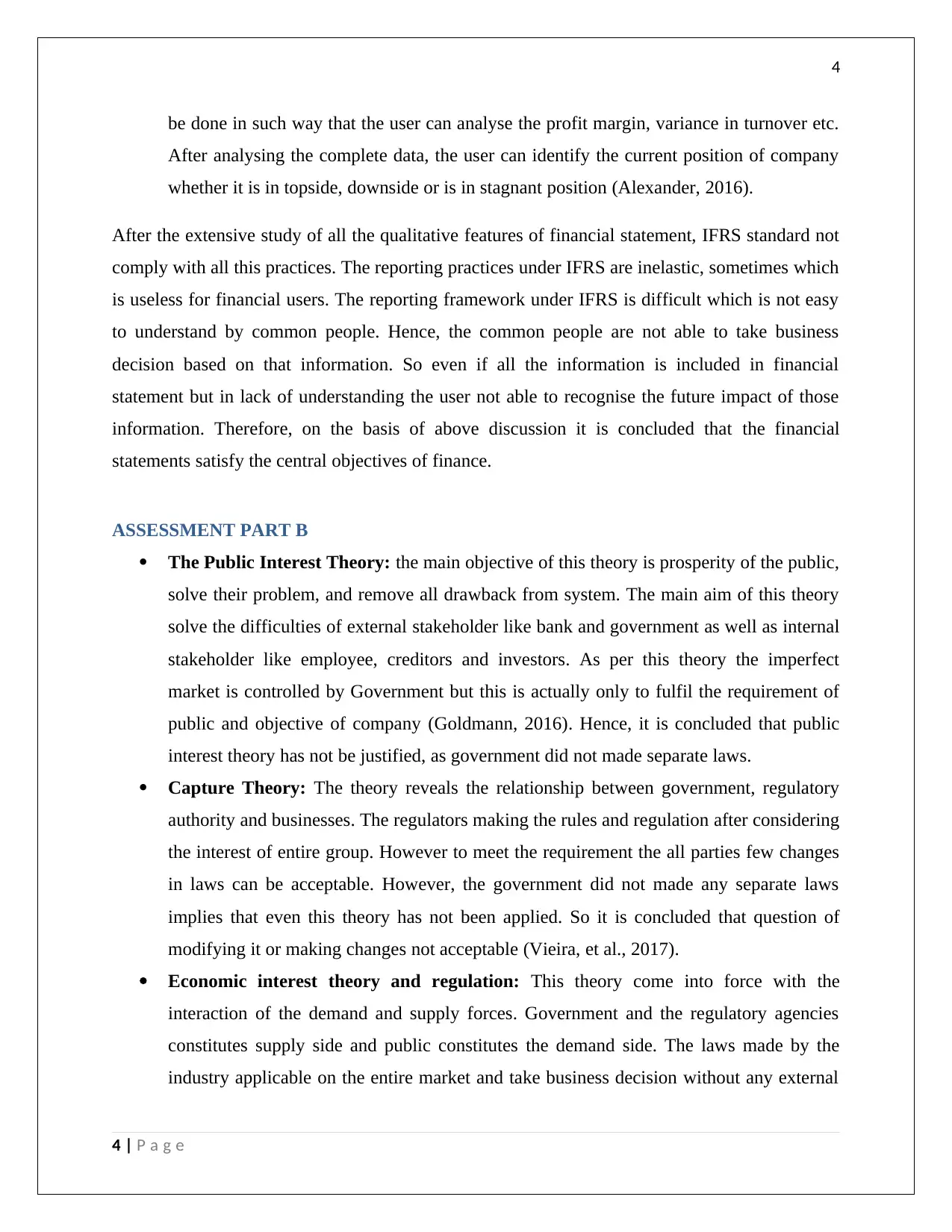
4
be done in such way that the user can analyse the profit margin, variance in turnover etc.
After analysing the complete data, the user can identify the current position of company
whether it is in topside, downside or is in stagnant position (Alexander, 2016).
After the extensive study of all the qualitative features of financial statement, IFRS standard not
comply with all this practices. The reporting practices under IFRS are inelastic, sometimes which
is useless for financial users. The reporting framework under IFRS is difficult which is not easy
to understand by common people. Hence, the common people are not able to take business
decision based on that information. So even if all the information is included in financial
statement but in lack of understanding the user not able to recognise the future impact of those
information. Therefore, on the basis of above discussion it is concluded that the financial
statements satisfy the central objectives of finance.
ASSESSMENT PART B
The Public Interest Theory: the main objective of this theory is prosperity of the public,
solve their problem, and remove all drawback from system. The main aim of this theory
solve the difficulties of external stakeholder like bank and government as well as internal
stakeholder like employee, creditors and investors. As per this theory the imperfect
market is controlled by Government but this is actually only to fulfil the requirement of
public and objective of company (Goldmann, 2016). Hence, it is concluded that public
interest theory has not be justified, as government did not made separate laws.
Capture Theory: The theory reveals the relationship between government, regulatory
authority and businesses. The regulators making the rules and regulation after considering
the interest of entire group. However to meet the requirement the all parties few changes
in laws can be acceptable. However, the government did not made any separate laws
implies that even this theory has not been applied. So it is concluded that question of
modifying it or making changes not acceptable (Vieira, et al., 2017).
Economic interest theory and regulation: This theory come into force with the
interaction of the demand and supply forces. Government and the regulatory agencies
constitutes supply side and public constitutes the demand side. The laws made by the
industry applicable on the entire market and take business decision without any external
4 | P a g e
be done in such way that the user can analyse the profit margin, variance in turnover etc.
After analysing the complete data, the user can identify the current position of company
whether it is in topside, downside or is in stagnant position (Alexander, 2016).
After the extensive study of all the qualitative features of financial statement, IFRS standard not
comply with all this practices. The reporting practices under IFRS are inelastic, sometimes which
is useless for financial users. The reporting framework under IFRS is difficult which is not easy
to understand by common people. Hence, the common people are not able to take business
decision based on that information. So even if all the information is included in financial
statement but in lack of understanding the user not able to recognise the future impact of those
information. Therefore, on the basis of above discussion it is concluded that the financial
statements satisfy the central objectives of finance.
ASSESSMENT PART B
The Public Interest Theory: the main objective of this theory is prosperity of the public,
solve their problem, and remove all drawback from system. The main aim of this theory
solve the difficulties of external stakeholder like bank and government as well as internal
stakeholder like employee, creditors and investors. As per this theory the imperfect
market is controlled by Government but this is actually only to fulfil the requirement of
public and objective of company (Goldmann, 2016). Hence, it is concluded that public
interest theory has not be justified, as government did not made separate laws.
Capture Theory: The theory reveals the relationship between government, regulatory
authority and businesses. The regulators making the rules and regulation after considering
the interest of entire group. However to meet the requirement the all parties few changes
in laws can be acceptable. However, the government did not made any separate laws
implies that even this theory has not been applied. So it is concluded that question of
modifying it or making changes not acceptable (Vieira, et al., 2017).
Economic interest theory and regulation: This theory come into force with the
interaction of the demand and supply forces. Government and the regulatory agencies
constitutes supply side and public constitutes the demand side. The laws made by the
industry applicable on the entire market and take business decision without any external
4 | P a g e
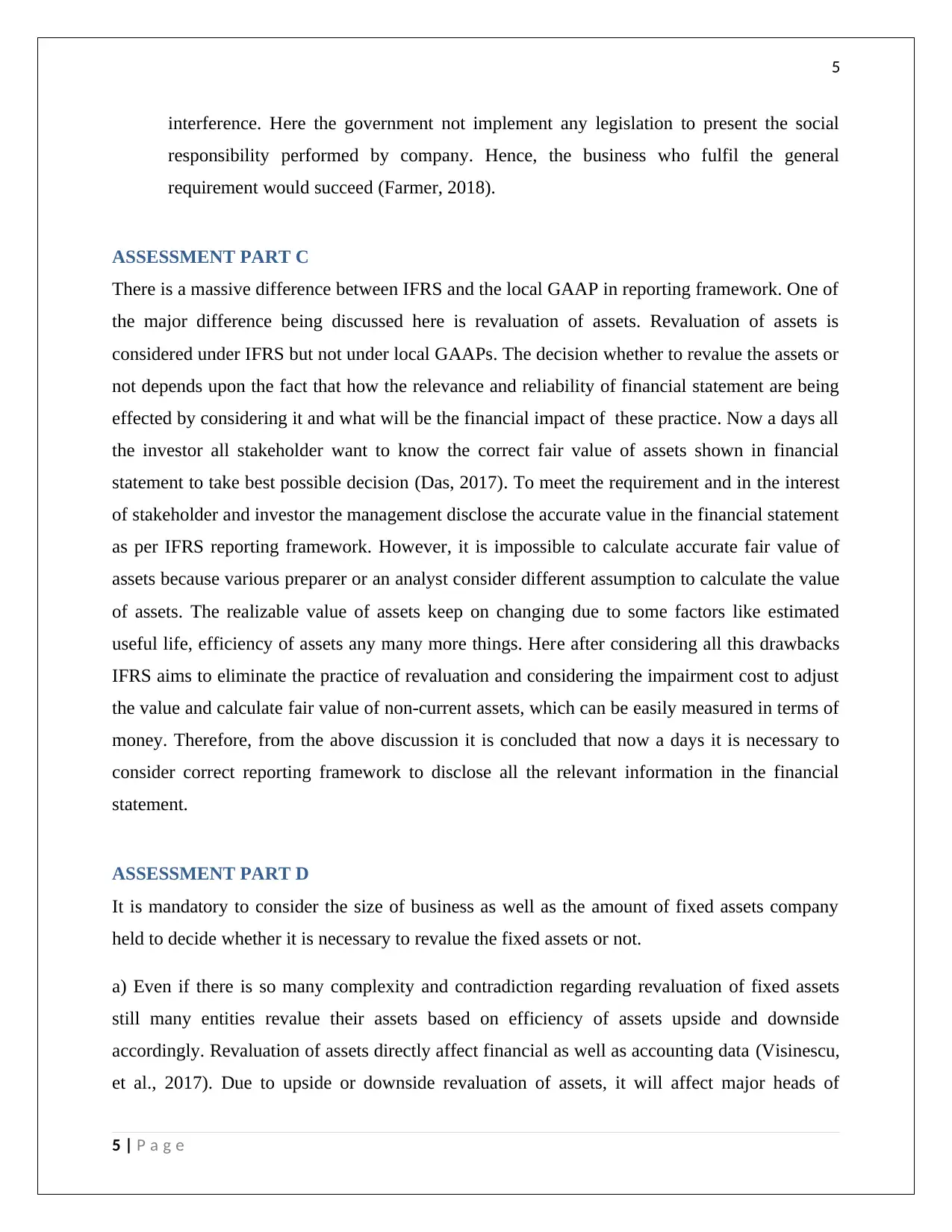
5
interference. Here the government not implement any legislation to present the social
responsibility performed by company. Hence, the business who fulfil the general
requirement would succeed (Farmer, 2018).
ASSESSMENT PART C
There is a massive difference between IFRS and the local GAAP in reporting framework. One of
the major difference being discussed here is revaluation of assets. Revaluation of assets is
considered under IFRS but not under local GAAPs. The decision whether to revalue the assets or
not depends upon the fact that how the relevance and reliability of financial statement are being
effected by considering it and what will be the financial impact of these practice. Now a days all
the investor all stakeholder want to know the correct fair value of assets shown in financial
statement to take best possible decision (Das, 2017). To meet the requirement and in the interest
of stakeholder and investor the management disclose the accurate value in the financial statement
as per IFRS reporting framework. However, it is impossible to calculate accurate fair value of
assets because various preparer or an analyst consider different assumption to calculate the value
of assets. The realizable value of assets keep on changing due to some factors like estimated
useful life, efficiency of assets any many more things. Here after considering all this drawbacks
IFRS aims to eliminate the practice of revaluation and considering the impairment cost to adjust
the value and calculate fair value of non-current assets, which can be easily measured in terms of
money. Therefore, from the above discussion it is concluded that now a days it is necessary to
consider correct reporting framework to disclose all the relevant information in the financial
statement.
ASSESSMENT PART D
It is mandatory to consider the size of business as well as the amount of fixed assets company
held to decide whether it is necessary to revalue the fixed assets or not.
a) Even if there is so many complexity and contradiction regarding revaluation of fixed assets
still many entities revalue their assets based on efficiency of assets upside and downside
accordingly. Revaluation of assets directly affect financial as well as accounting data (Visinescu,
et al., 2017). Due to upside or downside revaluation of assets, it will affect major heads of
5 | P a g e
interference. Here the government not implement any legislation to present the social
responsibility performed by company. Hence, the business who fulfil the general
requirement would succeed (Farmer, 2018).
ASSESSMENT PART C
There is a massive difference between IFRS and the local GAAP in reporting framework. One of
the major difference being discussed here is revaluation of assets. Revaluation of assets is
considered under IFRS but not under local GAAPs. The decision whether to revalue the assets or
not depends upon the fact that how the relevance and reliability of financial statement are being
effected by considering it and what will be the financial impact of these practice. Now a days all
the investor all stakeholder want to know the correct fair value of assets shown in financial
statement to take best possible decision (Das, 2017). To meet the requirement and in the interest
of stakeholder and investor the management disclose the accurate value in the financial statement
as per IFRS reporting framework. However, it is impossible to calculate accurate fair value of
assets because various preparer or an analyst consider different assumption to calculate the value
of assets. The realizable value of assets keep on changing due to some factors like estimated
useful life, efficiency of assets any many more things. Here after considering all this drawbacks
IFRS aims to eliminate the practice of revaluation and considering the impairment cost to adjust
the value and calculate fair value of non-current assets, which can be easily measured in terms of
money. Therefore, from the above discussion it is concluded that now a days it is necessary to
consider correct reporting framework to disclose all the relevant information in the financial
statement.
ASSESSMENT PART D
It is mandatory to consider the size of business as well as the amount of fixed assets company
held to decide whether it is necessary to revalue the fixed assets or not.
a) Even if there is so many complexity and contradiction regarding revaluation of fixed assets
still many entities revalue their assets based on efficiency of assets upside and downside
accordingly. Revaluation of assets directly affect financial as well as accounting data (Visinescu,
et al., 2017). Due to upside or downside revaluation of assets, it will affect major heads of
5 | P a g e
⊘ This is a preview!⊘
Do you want full access?
Subscribe today to unlock all pages.

Trusted by 1+ million students worldwide
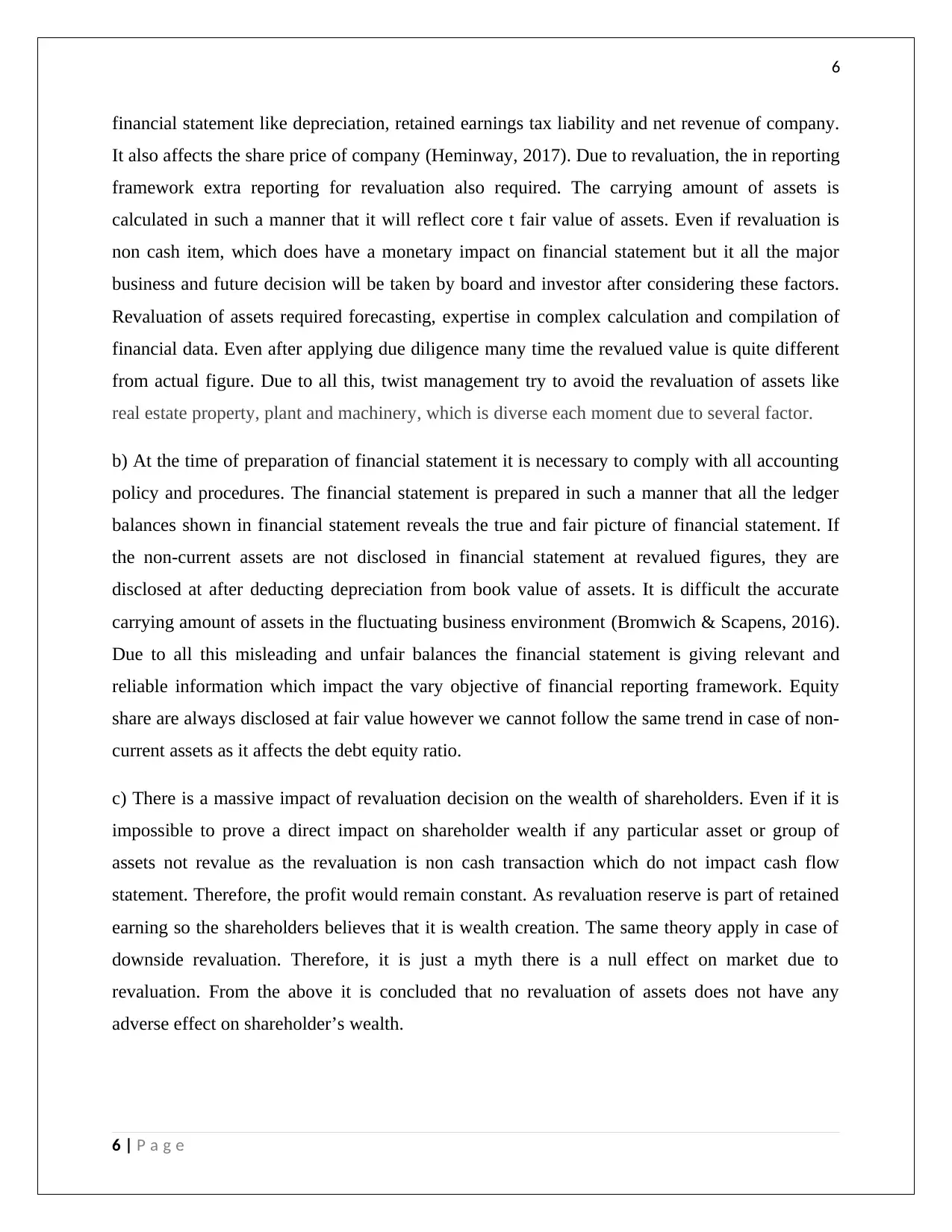
6
financial statement like depreciation, retained earnings tax liability and net revenue of company.
It also affects the share price of company (Heminway, 2017). Due to revaluation, the in reporting
framework extra reporting for revaluation also required. The carrying amount of assets is
calculated in such a manner that it will reflect core t fair value of assets. Even if revaluation is
non cash item, which does have a monetary impact on financial statement but it all the major
business and future decision will be taken by board and investor after considering these factors.
Revaluation of assets required forecasting, expertise in complex calculation and compilation of
financial data. Even after applying due diligence many time the revalued value is quite different
from actual figure. Due to all this, twist management try to avoid the revaluation of assets like
real estate property, plant and machinery, which is diverse each moment due to several factor.
b) At the time of preparation of financial statement it is necessary to comply with all accounting
policy and procedures. The financial statement is prepared in such a manner that all the ledger
balances shown in financial statement reveals the true and fair picture of financial statement. If
the non-current assets are not disclosed in financial statement at revalued figures, they are
disclosed at after deducting depreciation from book value of assets. It is difficult the accurate
carrying amount of assets in the fluctuating business environment (Bromwich & Scapens, 2016).
Due to all this misleading and unfair balances the financial statement is giving relevant and
reliable information which impact the vary objective of financial reporting framework. Equity
share are always disclosed at fair value however we cannot follow the same trend in case of non-
current assets as it affects the debt equity ratio.
c) There is a massive impact of revaluation decision on the wealth of shareholders. Even if it is
impossible to prove a direct impact on shareholder wealth if any particular asset or group of
assets not revalue as the revaluation is non cash transaction which do not impact cash flow
statement. Therefore, the profit would remain constant. As revaluation reserve is part of retained
earning so the shareholders believes that it is wealth creation. The same theory apply in case of
downside revaluation. Therefore, it is just a myth there is a null effect on market due to
revaluation. From the above it is concluded that no revaluation of assets does not have any
adverse effect on shareholder’s wealth.
6 | P a g e
financial statement like depreciation, retained earnings tax liability and net revenue of company.
It also affects the share price of company (Heminway, 2017). Due to revaluation, the in reporting
framework extra reporting for revaluation also required. The carrying amount of assets is
calculated in such a manner that it will reflect core t fair value of assets. Even if revaluation is
non cash item, which does have a monetary impact on financial statement but it all the major
business and future decision will be taken by board and investor after considering these factors.
Revaluation of assets required forecasting, expertise in complex calculation and compilation of
financial data. Even after applying due diligence many time the revalued value is quite different
from actual figure. Due to all this, twist management try to avoid the revaluation of assets like
real estate property, plant and machinery, which is diverse each moment due to several factor.
b) At the time of preparation of financial statement it is necessary to comply with all accounting
policy and procedures. The financial statement is prepared in such a manner that all the ledger
balances shown in financial statement reveals the true and fair picture of financial statement. If
the non-current assets are not disclosed in financial statement at revalued figures, they are
disclosed at after deducting depreciation from book value of assets. It is difficult the accurate
carrying amount of assets in the fluctuating business environment (Bromwich & Scapens, 2016).
Due to all this misleading and unfair balances the financial statement is giving relevant and
reliable information which impact the vary objective of financial reporting framework. Equity
share are always disclosed at fair value however we cannot follow the same trend in case of non-
current assets as it affects the debt equity ratio.
c) There is a massive impact of revaluation decision on the wealth of shareholders. Even if it is
impossible to prove a direct impact on shareholder wealth if any particular asset or group of
assets not revalue as the revaluation is non cash transaction which do not impact cash flow
statement. Therefore, the profit would remain constant. As revaluation reserve is part of retained
earning so the shareholders believes that it is wealth creation. The same theory apply in case of
downside revaluation. Therefore, it is just a myth there is a null effect on market due to
revaluation. From the above it is concluded that no revaluation of assets does not have any
adverse effect on shareholder’s wealth.
6 | P a g e
Paraphrase This Document
Need a fresh take? Get an instant paraphrase of this document with our AI Paraphraser
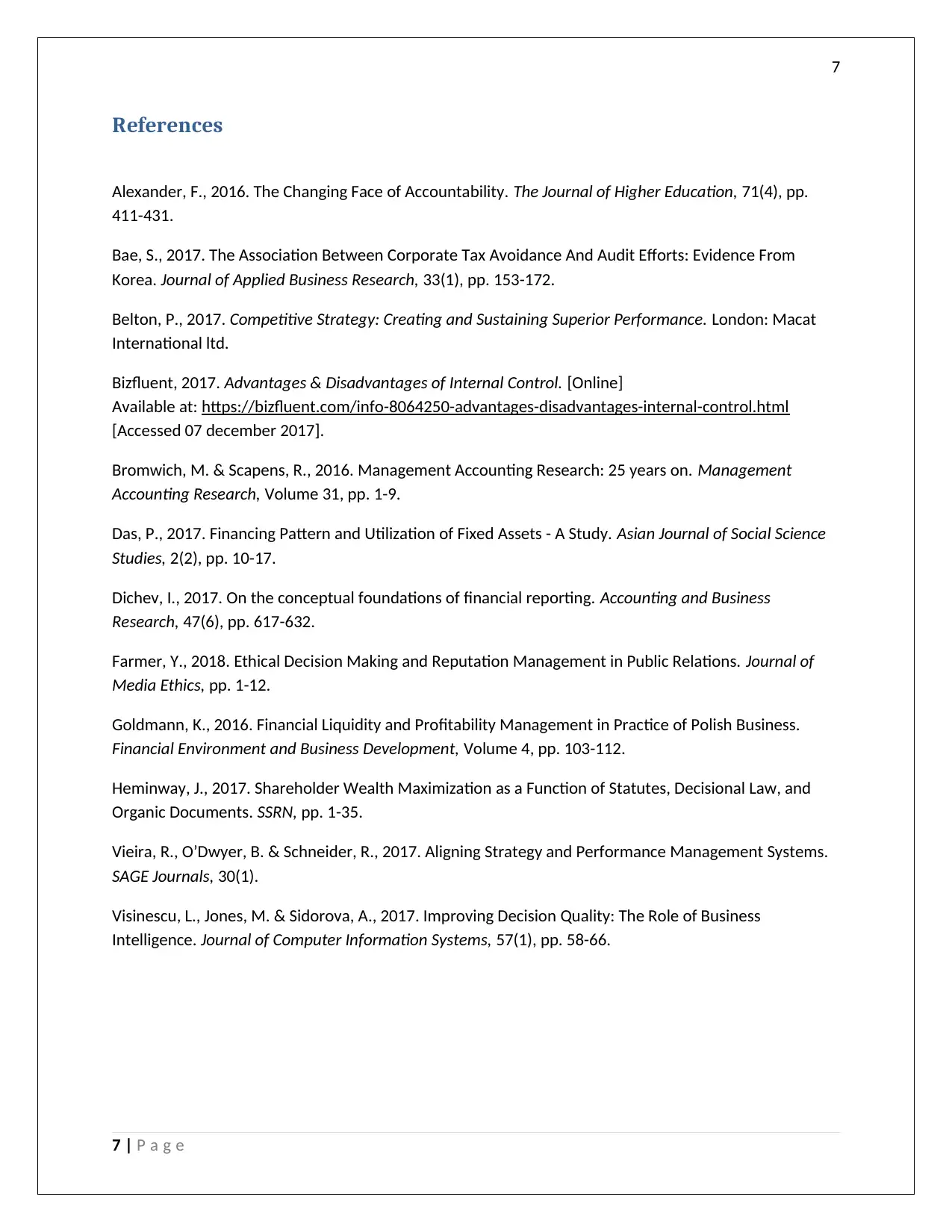
7
References
Alexander, F., 2016. The Changing Face of Accountability. The Journal of Higher Education, 71(4), pp.
411-431.
Bae, S., 2017. The Association Between Corporate Tax Avoidance And Audit Efforts: Evidence From
Korea. Journal of Applied Business Research, 33(1), pp. 153-172.
Belton, P., 2017. Competitive Strategy: Creating and Sustaining Superior Performance. London: Macat
International ltd.
Bizfluent, 2017. Advantages & Disadvantages of Internal Control. [Online]
Available at: https://bizfluent.com/info-8064250-advantages-disadvantages-internal-control.html
[Accessed 07 december 2017].
Bromwich, M. & Scapens, R., 2016. Management Accounting Research: 25 years on. Management
Accounting Research, Volume 31, pp. 1-9.
Das, P., 2017. Financing Pattern and Utilization of Fixed Assets - A Study. Asian Journal of Social Science
Studies, 2(2), pp. 10-17.
Dichev, I., 2017. On the conceptual foundations of financial reporting. Accounting and Business
Research, 47(6), pp. 617-632.
Farmer, Y., 2018. Ethical Decision Making and Reputation Management in Public Relations. Journal of
Media Ethics, pp. 1-12.
Goldmann, K., 2016. Financial Liquidity and Profitability Management in Practice of Polish Business.
Financial Environment and Business Development, Volume 4, pp. 103-112.
Heminway, J., 2017. Shareholder Wealth Maximization as a Function of Statutes, Decisional Law, and
Organic Documents. SSRN, pp. 1-35.
Vieira, R., O’Dwyer, B. & Schneider, R., 2017. Aligning Strategy and Performance Management Systems.
SAGE Journals, 30(1).
Visinescu, L., Jones, M. & Sidorova, A., 2017. Improving Decision Quality: The Role of Business
Intelligence. Journal of Computer Information Systems, 57(1), pp. 58-66.
7 | P a g e
References
Alexander, F., 2016. The Changing Face of Accountability. The Journal of Higher Education, 71(4), pp.
411-431.
Bae, S., 2017. The Association Between Corporate Tax Avoidance And Audit Efforts: Evidence From
Korea. Journal of Applied Business Research, 33(1), pp. 153-172.
Belton, P., 2017. Competitive Strategy: Creating and Sustaining Superior Performance. London: Macat
International ltd.
Bizfluent, 2017. Advantages & Disadvantages of Internal Control. [Online]
Available at: https://bizfluent.com/info-8064250-advantages-disadvantages-internal-control.html
[Accessed 07 december 2017].
Bromwich, M. & Scapens, R., 2016. Management Accounting Research: 25 years on. Management
Accounting Research, Volume 31, pp. 1-9.
Das, P., 2017. Financing Pattern and Utilization of Fixed Assets - A Study. Asian Journal of Social Science
Studies, 2(2), pp. 10-17.
Dichev, I., 2017. On the conceptual foundations of financial reporting. Accounting and Business
Research, 47(6), pp. 617-632.
Farmer, Y., 2018. Ethical Decision Making and Reputation Management in Public Relations. Journal of
Media Ethics, pp. 1-12.
Goldmann, K., 2016. Financial Liquidity and Profitability Management in Practice of Polish Business.
Financial Environment and Business Development, Volume 4, pp. 103-112.
Heminway, J., 2017. Shareholder Wealth Maximization as a Function of Statutes, Decisional Law, and
Organic Documents. SSRN, pp. 1-35.
Vieira, R., O’Dwyer, B. & Schneider, R., 2017. Aligning Strategy and Performance Management Systems.
SAGE Journals, 30(1).
Visinescu, L., Jones, M. & Sidorova, A., 2017. Improving Decision Quality: The Role of Business
Intelligence. Journal of Computer Information Systems, 57(1), pp. 58-66.
7 | P a g e
1 out of 8
Related Documents
Your All-in-One AI-Powered Toolkit for Academic Success.
+13062052269
info@desklib.com
Available 24*7 on WhatsApp / Email
![[object Object]](/_next/static/media/star-bottom.7253800d.svg)
Unlock your academic potential
Copyright © 2020–2025 A2Z Services. All Rights Reserved. Developed and managed by ZUCOL.





